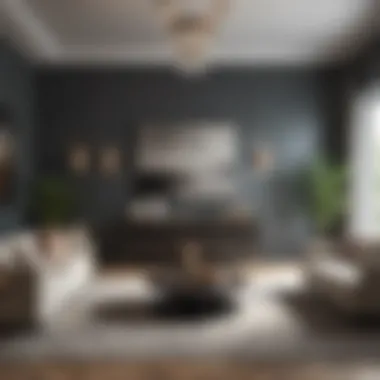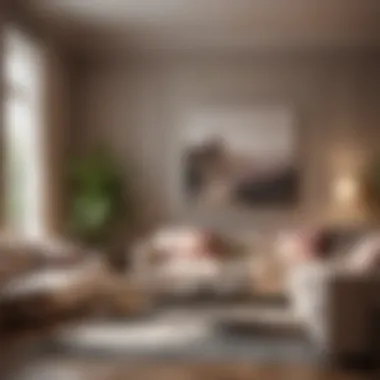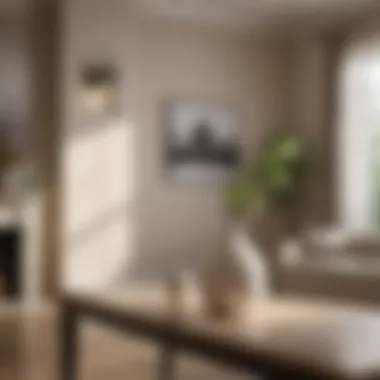Choosing the Best Paint Finish for Your Living Room


Intro
Choosing the right paint finish for a living room goes beyond aesthetic preferences. It directly impacts the room's functionality and overall ambiance. Every living space has unique characteristics that demand thoughtful consideration, especially when it comes to durability and maintenance. This article will explore various paint finishes suitable for living rooms, highlighting their features, benefits, and practical applications. By understanding the distinct qualities of different finishes, homeowners can make informed choices that align with their lifestyle and design vision.
Design Inspiration
Current Interior Design Trends
Today’s design trends emphasize comfort and versatility. Neutral tones continue to dominate, giving homeowners a blank canvas to showcase their unique taste. Matte finishes are often favored for their soft, understated look. However, there is a growing interest in semi-gloss options, especially in spaces that require a touch more sophistication and reflectivity.
Understanding these trends aids in selecting the right paint finish. You want something that not only complements your decor but also enhances the architectural elements of your living room.
Color Palettes and Their Effects
The color you choose sets the tone for your living space. It can evoke emotions and dictate the overall atmosphere.
- Warm colors like reds and yellows create an inviting and energetic environment.
- Cool colors, such as blues and greens, foster a calm and soothing atmosphere.
When selecting a paint finish, consider how the color and finish interact. A satin or eggshell finish can enhance the depth of warm tones, while a flat finish may soften cooler hues.
With the proper color palette, you can ensure your living room remains not only stylish but also an enjoyable place to relax.
"The right paint finish can not only improve the look of your walls but also enhance the functionality of your living space."
Practical Considerations for Paint Finishes
When deciding on a paint finish, several factors warrant attention: durability, washability, and compatibility.
Durability is crucial, especially in homes with children or pets. Gloss and semi-gloss finishes are easier to clean and generally withstand wear and tear better than flat options. Some key points include:
- Eggshell finish: Durable yet subtle, easy to clean.
- Satin finish: Offers a sheen that reflects light, suitable for both walls and trim.
- Flat finish: Highly aesthetic, but less resistant to stains and dirt.
Washability is important too. High-traffic areas benefit from finishes that can withstand regular cleaning. Semi-gloss is ideal for living rooms, offering a good balance between elegance and practicality. Likewise, compatibility with existing decor is essential. Ensure the finish complements current furnishings and architectural elements.
Ultimately, the right finish will unify the design while serving practical needs. A well-thought-out choice enhances not just the beauty of the living room but also its functionality, making it a truly inviting space to unwind.
Understanding Paint Finishes
In the realm of interior design, understanding paint finishes holds a significant weight. The paint finish you choose for your living room influences not only the aesthetic but also the functionality of the space. Paint finishes come with unique characteristics that determine how they will interact with light, durability, and maintenance. This knowledge enables homeowners, interior design enthusiasts, and even party hosts to create an environment that resonates with their personal style and meets their daily needs.
Definition and Importance
Paint finishes refer to the sheen or gloss level of the paint used on walls or surfaces. They play a crucial role in the overall look of a room. High-gloss finishes may create a modern and polished feel, while a matte finish might give a more subtle and comfortable vibe. The choice of finish impacts how colors appear under various lighting conditions and can even influence the perception of space size. For instance, lighter, glossier finishes tend to reflect more light, making a room feel more spacious, while darker matte shades can create a cozy atmosphere.
The importance of defining and understanding paint finishes lies in making informed choices. Homeowners should consider the lifestyle of the occupants. Spaces with high foot traffic may benefit from durable finishes, while a quiet reading nook may prioritize a softer aesthetic.
Role in Interior Design
In interior design, the concept of paint finishes is intertwined with creating a cohesive and functional environment. It is not merely about color; the finish contributes to the texture and depth of the space. Using different finishes on various elements can guide the eye and create focal points. For example, a satin finish can draw attention to architectural details while a matte finish on the main walls can offer a calming backdrop for art pieces or furniture.
Moreover, finishes affect decoration and furniture selection. A glossy wall can clash with heavily textured fabrics, while a smooth matte will harmonize better with modern decor. Therefore, understanding how paint finishes interact with other elements in a room helps in achieving a balanced design.
By carefully selecting paint finishes based on their definitions and vital roles in design, one can create a living room that is not just visually appealing but also functional and personalized.
Types of Paint Finishes
Understanding the nuances of different paint finishes is essential for any homeowner or interior design enthusiast. Choosing the right finish impacts the aesthetics and functionality of the living room.
Each type of paint finish possesses distinct qualities that cater to varying needs and preferences. From matte to gloss, these finishes influence not only the visual appeal but also maintenance requirements and durability of walls. It’s crucial to align the choice of finish with the room's characteristics, lifestyle considerations, and existing decor.
Matte Finish
Characteristics


Matte finish paint is known for its flat surface. It does not reflect light, allowing colors to appear deeper and more vibrant. This finish can help hide wall imperfections, making it a popular choice for ceilings or less trafficked areas. The absence of gloss contributes to a more contemporary and understated look, making spaces feel cozy.
Advantages
One significant advantage of a matte finish is its ability to create a calm environment. It absorbs light rather than reflecting it, which can enhance the overall ambiance of a living room. Moreover, applying matte paint is relatively easy as it tends to hide application marks and roller lines better than glossier paints.
Disadvantages
However, matte finishes are not without drawbacks. They can be harder to clean, as scrubbing may damage the paint. For high-traffic areas or homes with children and pets, this might not be the best choice. Additionally, matte finishes tend to require more frequent touch-ups, as they can show wear more readily than other finishes.
Eggshell Finish
Characteristics
Eggshell finish offers a slight sheen and is a compromise between matte and satin finishes. This paint type is less reflective than satin, yet provides a silky appearance. It retains a softness that can complement various decorative styles.
Advantages
The key advantage of eggshell is its washability. It is easier to clean than a matte finish, making it suitable for living rooms where you want style without sacrificing practicality. The light reflectivity can brighten a room without overwhelming it, thus enhancing the overall brightness.
Disadvantages
On the downside, while eggshell is easy to clean, it does not hide imperfections as well as matte finishes. This means if walls have visible flaws, they might need additional preparation before painting with eggshell finish. The application also requires a steady hand, as it can show brush strokes more than its matte counterpart.
Satin Finish
Characteristics
Satin finish is recognized for its soft glow and greater durability. It reflects some light without being overly shiny, giving walls a subtle richness. This finish is often chosen for higher traffic areas and spaces that require more frequent cleaning.
Advantages
One of the major advantages of satin finish is its durability. It is more resistant to moisture and can handle scrubbing, which makes it ideal for family rooms or areas exposed to spills. The aesthetic appeal of a satin finish can elevate the living space while remaining functional.
Disadvantages
The potential downside of satin is its reflective quality, which can highlight imperfections on the wall surface. If your walls are not in perfect shape, these details may be more pronounced. Also, for those desiring a completely flat appearance, satin may lean too shiny for their preference.
Semi-Gloss Finish
Characteristics
Semi-gloss paint provides a shiny finish that reflects more light than satin. It is commonly used on trim, molding, and areas that demand durability. This finish combines the best of both worlds: it is glossy but not overly reflective.
Advantages
The primary benefit of a semi-gloss finish is its resilience. It holds up well to washing and is great for high-traffic areas. It can impart a polished look while standing up to the demands of daily life in a busy home.
Disadvantages
Nevertheless, semi-gloss finishes can sometimes draw attention to wall imperfections, similarly to satin. Furthermore, it can be harder to apply evenly, often requiring more experience to achieve a flawless look than flatter finishes.
Gloss Finish
Characteristics
Gloss finish is the most reflective option. It shines brightly and is typically used in spaces where you want a striking visual impact. Gloss paint can give walls a modern look and is often seen in contemporary designs.
Advantages


A gloss finish’s significant advantages include its high durability and easy cleaning process. It is ideal for areas that undergo frequent cleaning. Gloss paint also serves to enlarge spaces visually, as it reflects light effectively.
Disadvantages
However, its extreme shine may not suit everyone's taste and can make surface imperfections more noticeable. It can also be challenging to apply as it leaves marks if not done correctly. For some, the glossy effect may seem too harsh or stark.
Each type of paint finish contributes uniquely to the overall character of your living room. Selecting the right finish is a balance of aesthetics and practicality.
Factors to Consider When Choosing Paint Finishes
Choosing the right paint finish is more than just a matter of aesthetics; it can significantly affect both the ambiance and functionality of a living room. Each paint finish has its own set of characteristics that interact with elements such as light, wall texture, and existing decor. Therefore, understanding these factors is essential for making an informed decision that harmonizes with your personal style and practical needs. Below are the crucial elements to consider when selecting a paint finish for your living space, ensuring that your choice contributes to the overall coherence of your home.
Room Size and Lighting
The size of your living room and how light enters the space are critical factors in selecting a paint finish. In smaller rooms, lighter finishes can create an illusion of spaciousness and brightness. On the contrary, darker or textured finishes can help define areas or create a warm atmosphere, making a space feel cozy.
Light reflects off different finishes in varied ways. Glossy finishes tend to enhance brightness, reflecting more light, which can be advantageous in dimly lit areas. Conversely, matte finishes can absorb light, making them more suitable for spaces with abundant natural light, as they won’t create glare. Consider testing samples in various lighting conditions to see how they react throughout the day.
Wall Texture
The texture of your walls state the groundwork for what type of finish will work best. If your walls are smooth, you have more flexibility in choosing a finish. Satin or semi-gloss finishes can lend a polished feel, enhancing the elegance of your space.
For textured walls, a matte or eggshell finish can soften imperfections, offering a more forgiving look while diffusing light evenly across the surface. It’s crucial to assess your wall's current condition—cracks, bumps, and unevenness may all influence your finish choice.
Functionality and Durability
Understanding your living room's use is vital when selecting a paint finish. High-traffic areas may benefit from durable finishes that resist scuff marks and cleaning. Satin and semi-gloss finishes are often recommended for these spaces because they are easier to clean and maintain. They can withstand the rigors of day-to-day activities without sacrificing their aesthetic appeal.
Moreover, consider the wear and tear from children or pets. In such cases, choosing a robust finish can save time and money in the long run as it requires less frequent repaints. Durability should align with your functional needs while also meeting the visual requirements of the room.
Existing Decor and Color Palette
The current decor of your living room plays a significant role in determining the paint finish. Your selected finish should not only harmonize with the color palette but also complement existing furniture and textures.
If your decor leans toward a modern aesthetic, higher gloss finishes can introduce a sense of sleekness. In contrast, a more traditional or rustic decor style may resonate better with matte finishes that offer a softer, muted appearance. Always consider how colors and finishes will interact with light and your existing design elements. Assessing your overall vision for the space can create a cohesive look that feels intentional and thoughtfully designed.
How to Test Paint Finishes
Testing paint finishes is a critical step in the decision-making process for homeowners and interior design enthusiasts. It ensures that the selected finish will not only match the aesthetic vision but also function well in the specific environment of the living room. Without proper testing, there is a risk of ending up with a finish that does not perform as expected, resulting in dissatisfaction and potential extra costs for repainting or repairs.
Creating Sample Swatches
Creating sample swatches is essential to visualize how different paint finishes appear on your walls. To start, select a few colors and finishes that interest you. Purchase small samples or paint pots from brands like Sherwin-Williams or Benjamin Moore. Once you have your samples, apply them on a section of the wall or on large poster boards for more flexibility.
When applying the swatches, ensure the surface is clean and properly prepped. This guarantees a smoother application and a truer representation of the finish. Apply two coats to achieve full depth of color and finish, as some paints may require multiple layers for full effect. After the samples have dried, observe how they look at different angles and from varying distances.
It's also a good idea to place swatches near existing furniture or decor. This allows for a more accurate assessment of how the finish complements your living room's overall design. Furthermore, documenting your process can help you recall which finishes you preferred.
Assessing Under Different Lighting Conditions
Assessing paint finishes under different lighting conditions is crucial, as lighting can drastically alter a finish's appearance. First, assess how your swatches look in natural light throughout the day. Morning light appears cooler, reflecting blue tones, while afternoon light tends to be warm. You might find the same color looks different from morning to evening.
Additionally, artificial lighting will also impact how the finish is perceived. A warm white bulb may highlight certain hues in a paint that cooler lights do not, and vice versa. Test your samples under the same lighting that will primarily be used in the room, whether that’s overhead lights, lamps, or sconces.
It’s worth taking notes on how each finish reflects light. For instance, glossier finishes often enhance brightness by reflecting more light, while matte finishes can absorb it, giving a softer, cozier effect.
"The key to selecting the perfect paint finish for your living room lies within the details of testing. Observe closely, and allow factors like lighting and furniture to guide your choice, ensuring satisfaction with your selection."
Application Techniques for Various Finishes


The application techniques for paint finishes are a critical aspect of achieving the desired aesthetic and durability in a living room. Understanding the proper methods ensures that the paint adheres well, maintains its appearance over time, and covers imperfections effectively. Careful application is not just about achieving a nice look; it also enhances the longevity of the paint job, which is particularly important in high-traffic areas like living rooms.
Preparation of Surfaces
Before applying any paint finish, the surfaces must be adequately prepared. This process includes cleaning the walls to remove dust, grease, or any other contaminants that may interfere with adhesion. Improperly prepared surfaces can lead to peeling or uneven texture over time.
- Clean the Walls: Use a mild soap solution and a sponge. Rinse with clean water.
- Repair Damages: Fill in any cracks or holes with a suitable filler, allowing it to cure properly. Sand the area smooth once dry.
- Prime the Surfaces: Depending on the type of paint finish and the existing wall color, a primer may be needed. Primers provide a uniform surface, ensuring better color coverage and adhesion.
Tools and Materials Required
Equipping yourself with the right tools and materials can make the painting process smoother and more efficient. Below are essential items needed for applying various paint finishes:
- Paint: Choose the specific finish you want, whether matte, eggshell, satin, semi-gloss, or gloss.
- Primer: A good quality primer suitable for the surface type.
- Brushes: A variety of brushes for edging and detailed work, typically angled and flat brushes depending on the area to cover.
- Rollers: For quicker covering of larger wall areas, use a roller with a suitable nap length based on wall texture.
- Paint Tray: A tray to hold paint for easier access.
- Drop Cloths: Protect flooring and furniture from spills and splatters.
- Masking Tape: To achieve clean edges around trim and adjacent wall colors.
- Sandpaper: For smoothing surfaces after repairs.
Step-by-Step Application Guide
Applying paint finishes requires precision. Follow these steps for optimal results:
- Set Up the Area: Move furniture and cover the floor with drop cloths. Ensure adequate ventilation in the space.
- Tape Edges: Apply masking tape along trim, windows, and any areas where paint should not go. This helps create sharp lines.
- Prime if Necessary: If using primer, apply it evenly and allow it to dry completely.
- Start Edging: Use an angled brush to carefully cut in along edges first, painting a few inches from corners and ceilings.
- Roll the Walls: Dip the roller into the paint tray, rolling it on the tray to remove excess. Apply the paint in a ‘W’ pattern across the wall for an even coat.
- Second Coat: Once the first coat dries (check manufacturer’s instructions for drying time), apply a second coat if needed for full coverage.
- Finish and Clean Up: Remove masking tape while the paint is slightly wet to avoid peeling. Clean brushes and tools immediately after use.
Applying paint finishes correctly is essential for achieving a professional look. Proper preparation and application techniques can greatly influence the overall results.
Maintenance and Care of Painted Surfaces
The longevity and visual appeal of painted walls heavily depend on proper maintenance and care. A well-maintained finish not only enhances the beauty of a living room but also ensures that it endures daily wear and tear. Understanding how to care for the various paint finishes is essential for homeowners and design enthusiasts. From cleaning methods to knowing when to repaint, these practices will help maintain the integrity and aesthetics of living spaces.
Cleaning Techniques for Different Finishes
Maintaining the cleanliness of painted surfaces begins with recognizing the type of finish used. Each finish requires specific care techniques, as improper cleaning might damage the surface or diminish its appearance.
- Matte Finish: This type is sensitive to scrubbing. Use a soft cloth dampened with water to blot away stains. Avoid any acidic or harsh cleaners.
- Eggshell Finish: Slightly more durable than matte, yet still needs gentle care. A mixture of mild soap and water is usually sufficient. Soft sponges work well for this finish.
- Satin Finish: This finish is more washable and can withstand some scrubbing. Use a sponge with a mild detergent for tougher stains.
- Semi-Gloss Finish: This is highly resistant to stains. A mixture of vinegar and water or multipurpose cleaners can effectively clean this finish.
- Gloss Finish: The most durable, gloss finishes can handle stronger cleaners. You can use a mix of warm water and a gentle cleaner without damaging the shine.
In all cases, test any cleaning solution on a small area first. This approach helps prevent discoloration or damage to the paint.
When to Repaint
Knowing when to repaint is crucial for interior maintenance. Signs may vary based on the finish type used, the room’s lighting, and its usage.
- Fading or discoloration: If colors seem less vibrant, it may be time to refresh the paint. Sunlight and humidity can impact this.
- Peeling or flaking: This indicates significant deterioration. Address this immediately to prevent further damage to the wall.
- Damages or stains: If stains do not come off despite cleaning efforts, repainting is often the best solution.
- Changing decor: If you are redecorating or changing the layout of your living room, a fresh coat of paint can help tie the new elements together.
Regular assessments will help protect walls and maintain a fresh look in your living space. Most finishes benefit from a repaint every five to ten years, depending on the product and exposure to factors like sunlight and moisture. If unsure, consulting a professional can provide tailored advice for specific conditions.
"Proper maintenance prolongs the life of a paint finish, ensuring the aesthetic cohesion of your living space."
Understanding cleaning techniques and recognizing when to repaint will ensure that your living room retains its charm and beauty. This awareness ultimately leads to a space that reflects personal style and hospitality.
Culmination
Selecting the right paint finish for a living room has a significant impact on both visual appeal and practical use. It is not just about color; it’s about how the finish interacts with light, how easy it is to maintain, and how well it complements the existing decor. Each finish offers unique benefits and drawbacks, making it essential to understand their characteristics.
In this article, we have discussed five types of finishes: matte, eggshell, satin, semi-gloss, and gloss. Each of these brings its own qualities to a space. From the soft, high-contrast look of a matte finish to the reflective qualities of gloss, each variation can dramatically change the atmosphere.
When considering paint finishes, durability and washability stand out as key factors. Choosing a finish that can withstand wear and tear, especially in high-traffic areas or spaces used by children or pets, is crucial. Additionally, factors such as room size, wall texture, and how much natural light enters a space will influence your final decision.
As we wrap up, remember that testing paint swatches and observing them under different lighting conditions can provide further clarity. Getting a realistic sense of how a finish will appear in your living room is a step that cannot be overlooked.
Ultimately, the right paint finish ties together your design choices, enhancing the living room’s appeal while meeting your functionality requirements. With careful consideration and a clear understanding of your needs, you can choose a finish that you will enjoy for years to come.
Recap and Final Thoughts
To summarize, a living room’s paint finish is an essential component of its overall design. The chosen finish affects not only aesthetics but also how the space functions daily. Key points to consider include:
- Durability: Select a finish that can handle the demands of everyday living.
- Lighting: Different finishes react uniquely to light; observe samples in various conditions.
- Maintenance: Some finishes require more upkeep; consider your lifestyle and cleaning habits.
This comprehensive understanding of paint finishes should empower homeowners and design enthusiasts alike to make well-informed choices. A well-considered paint finish not only enhances the living space but also aligns with personal style and practical functionality.















